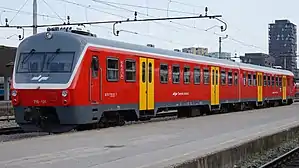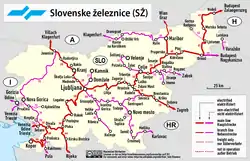Slovenian Railways
Slovenian Railways (Slovene: Slovenske železnice, SŽ) is the state railway company of Slovenia, created in 1991.
| Slovenian Railways | |||||||
|---|---|---|---|---|---|---|---|
 | |||||||
| Operation | |||||||
| National railway | Slovenske železnice | ||||||
| Statistics | |||||||
| Ridership | 13.42 million (2017)[1] | ||||||
| Passenger km | 650 million km (2017)[1] | ||||||
| Freight | 4.4 billion tonne-km (2017)[1] | ||||||
| System length | |||||||
| Total | 1,209 kilometres (751 mi)[1] | ||||||
| Double track | 331 km (206 mi)[1] | ||||||
| Electrified | 610 km (380 mi)[1] | ||||||
| Track gauge | |||||||
| Main | 1,435 mm (4 ft 8 1⁄2 in) standard gauge | ||||||
| High-speed | 1,435 mm (4 ft 8 1⁄2 in) | ||||||
| |||||||
Slovenia is a member of the International Union of Railways (UIC). The UIC Country Code for Slovenia is 79.
History

What is now Slovenia received its first railway connection in the 1840s, when the Austrian Empire built a railway connection - Südliche Staatsbahn or Austrian Southern Railway - between its capital, Vienna, and its major commercial port, Trieste. Thus, Maribor was connected by railway to Graz in 1844. The stretch was extended via Pragersko to Celje in 1846, and further via Zidani Most to Ljubljana in 1849. A double-track line was continued via Postojna, Pivka, and Divača, finally reaching Trieste in 1857.
Before World War I, numerous other railways were built. In 1860, Pragersko was connected to Ormož and further to Čakovec, Croatia, thus connecting the Austrian and the Hungarian part of the empire. In 1862, a single-track railway (expanded into double-track in 1944) along the Sava river was built, connecting Zidani Most with Zagreb. In 1863, the "Carinthian railway" was built along the Drava river, connecting Maribor with Dravograd, Klagenfurt and Villach. In 1870, a railway along the upper Sava river valley was built, connecting Ljubljana with Kranj, Jesenice and Tarvisio, Italy. In 1873, a line from Pivka via Illirska Bistrica connected Rijeka, then the most important commercial port in the Hungarian part of the empire. In 1876, a line from Divača connected Pula, the Austrian naval base, via Prešnica. In 1906, Bohinj Railway was built, connecting Villach with Jesenice, along the Soča river valley to Gorizia and further to Trieste, with two over-6000 meter tunnels.
Few lines were opened after World War I. One of them connected Ormož with Ljutomer and Murska Sobota, and opened in 1924. After World War II, a single-track electrified line connecting Prešnica with Koper was built in 1967.
Slovenian Railways (Slovene: Slovenske železnice, SŽ), the state railway company of Slovenia was created in 1991 from the Ljubljana division of the former Yugoslav Railways after the breakup of Yugoslavia.
In 1999, a single-track line between Murska Sobota and Hodoš was rebuilt, offering a direct connection with the Hungarian railway system. The line was originally built in 1907 and closed down in 1968 among numerous other lines closed down during the 1960s. In April 2016 the electrification of the Pragersko - Hodoš line was completed.[2]
Numerous ex-Yugoslav Railways steam locomotives are plinthed at stations around Slovenia and there is a railway museum at Ljubljana.
Rolling stock of the Slovenian Railways

 Stadler FLIRT DMU (SŽ 610/615)
Stadler FLIRT DMU (SŽ 610/615) Siemens Desiro (SŽ 312/317)
Siemens Desiro (SŽ 312/317)

System

Slovenian Railways operates 1,229 km of standard gauge tracks, 331 km as double track, and reaches all regions of the country. Slovenia is well connected by rail to all surrounding countries, reflecting the fact that it used to be part of the Austro-Hungarian Empire and later part of Yugoslavia. Left-hand running is used on double-track sections, unlike the remainder of the former Yugoslavian railways.
Electrification is provided by a 3 kV DC system and covers 610 km, with electrification from Pragersko to Hodoš on the Corridor V completed in April 2016. The remainder of the former Yugoslavian railways that have been electrified operate with the 25 kV AC system, so trains to Zagreb have to change engines at Dobova in case there aren't any dual voltage engines. The DC system was inherited from the Italian Ferrovie dello Stato on the Sežana-Pivka-Ilirska Bistrica-Šapjane line. Further electrification was conducted with the same system to preserve compatibility.
Rail links to adjacent countries
Crossroad of Pan-European corridors
Ljubljana is at the heart of the SŽ system. Here, the Pan-European corridors V and X intersect. These transportation corridors are being established to tie larger segments of Europe economically together: Corridor V links Venice - Trieste/Koper - Ljubljana - Maribor - Budapest - Kyiv, while Corridor X connects Salzburg - Ljubljana - Zagreb - Belgrade - Skopje - Thessalonica. The freight system to Koper, a modern and growing port near Trieste, represents the shortest connection to the Mediterranean for a large portion of the hinterland of Central and Eastern Europe.
In 2010, Slovenske železnice joined Cargo 10, a joint venture with other railways in the region.[3]
Passenger trains
InterCity Slovenija (ICS)
.jpg.webp)
The ICS trains are modern, air-conditioned trains which provide fast speeds and comfort. They are equipped with disabled access and other facilities. The passengers can buy food on board (from Monday to Friday), the 1st class passengers are offered food free of charge. There are also electric sockets in the 1st class department. The train is a tilting EMU. The reservation of a seat is obligatory and is included in the price of the ticket. Also included in the price of the ticket is the obligatory ICS supplement.[4]
The ICS trains run on the following line (note: the regular service runs between Maribor and Ljubljana. The Austria to Maribor part of the line is served by only one pair of trains a day. The section from Ljubljana to Koper runs only on summer Saturdays, Sundays and Bank Holidays.):
- Spielfeld-Straß (Austria)
- Maribor
- connection to Holmec and onwards to Austria
- Pragersko
- Celje
- connection to Velenje
- connection to Sveti Rok ob Sotli
- connection to Imeno
- Zidani Most
- connection to Dobova and onwards to Croatia
- Ljubljana
- connection to Rosalnice and onwards to Croatia
- connection to Jesenice and onwards to Austria
- connection to Kamnik Graben
- connection to Ljubljana Moste (BTC)
- Pivka
- connection to Ilirska Bistrica and onwards to Croatia
- Divača
- connection to Sežana
- Hrpelje-Kozina
- connection to Rakitovec and onwards to Croatia
- Koper
InterCity (IC)
The IC trains are quality trains serving longer distances in national and international traffic. They connect bigger towns, cities and tourist resorts. They consist of comfortable cars. They provide fast connection and call only at major stations. The train usually consists of open or compartment coaches (1st and 2nd class). Some of the trains may have a restaurant car. An IC supplement must be paid for this type of train.
EuroCity (EC)
The EC trains are high-quality trains serving important lines in international traffic. They connect important cities in Slovenia and the rest of Europe. The EC trains are even faster than the IC trains and they call at fewer stations. The majority of the EC trains include air-conditioned cars and have catering facilities on board. The train usually consists of open and compartment passenger coaches (1st and 2nd class). Some of the trains may have a restaurant car. An EC supplement must be paid for this type of train.
International trains (MV)
The MV trains (Slovene for mednarodni vlak, international train) are quality trains serving international lines. They do not call at minor stations. The train usually consists of open and compartment passenger coaches (1st and 2nd class). Some of the trains may have a restaurant car. An MV supplement must be paid for this type of train.
EuroNight (EN)
The EN trains are high-quality overnight international trains. They offer open or compartment passenger coaches (1st and 2nd class), couchette cars and sleeping cars. Some of the trains may have a restaurant car. The EC supplement must be paid for regular seats and an additional supplement must be paid for couchettes and sleeper cars. Some EN trains use "global" prices with an obligatory reservation.
Regional (RG) and local trains (LP)
The RG and LP (Slovene for lokalni potniški, local passenger train) trains are other trains, connecting all parts of Slovenia. They serve as commuter trains. On some lines, they are the only type of trains available, for example lines to Kamnik and Imeno. The trains offer 2nd class travel only. They are usually EMUs and DMUs on unelectrified lines.
Supplements
In addition to the supplements for faster trains, there is also one for tickets bought on the train instead of beforehand.[5] It is set at €2.50, and no discount is available for children, the elderly, groups, and so on.
Named trains
Many trains are assigned names. The examples include:[5]
- IC 502 / 503 "Pohorje"
- IC 518 / 519 "Ptuj"
- IC 516 / 517 "Mura"
- IC 508 / 509 "Dana"
- EC 210 / 211 "Sava"
- EC 150 / 151 "Emona"
- EC 158 / 159 "Croatia"
- EC 212 / 213 "Mimara"
- EC 246 / 247 "Citadella"
- MV 498 / 499 "Lisinski"
- MV 246 / 247 "Citadella"
- MV 414 / 415 "Alpine Pearls"
- MV 480 / 481 "Opatija"
- MV 482 / 483 "Ljubljana"
- MV 1472 / 1473 "Istra"
- RG 1604 / 1605 "Istra"
- RG 600 / 601 "Soča"
Railway operators
Besides Slovenia's national railway operator, Adria Transport, Slovenia's first open-access operator dedicated to freight transport, also operates in the nation's network.
See also
References
- "Railway Statistics – 2017 Synopsis" (PDF). International Union of Railways, IUC. 2017. Retrieved 11 June 2019.
- "Slovenia completes electrification of rail link to Hungary". June 13, 2016.
- "Balkan railways: From Berlin to Beijing?". The Economist. 26 September 2010. Retrieved 2010-09-26.
- "Vrste vlakov". Slovenske železnice (in Slovenian). 2020-04-20. Retrieved 2020-10-17.
- "Slovenske železnice - Error404 - Slovenske železnice". www.slo-zeleznice.si.


.JPG.webp)